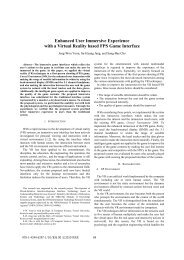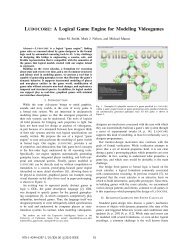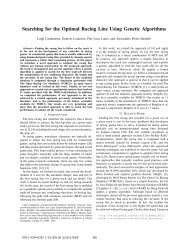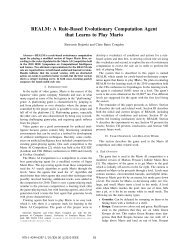an article in Science - Center for Computer Games Research
an article in Science - Center for Computer Games Research
an article in Science - Center for Computer Games Research
You also want an ePaper? Increase the reach of your titles
YUMPU automatically turns print PDFs into web optimized ePapers that Google loves.
MEETINGBRIEFS>><br />
IEEE INTERNATIONAL CONFERENCE ON COMPUTATIONAL INTELLIGENCE AND GAMES | 18–21 AUGUST 2010 | COPENHAGEN<br />
Game-M<strong>in</strong>ers Grapple<br />
With Massive Data<br />
After describ<strong>in</strong>g his methods with dozens of<br />
mathematical <strong>for</strong>mulae, Christi<strong>an</strong> Thurau’s<br />
next slide shows the result. It looks like a<br />
pile of f<strong>in</strong>e metal dust <strong>in</strong> a magnetic field,<br />
reveal<strong>in</strong>g the <strong>in</strong>visible l<strong>in</strong>es of <strong>for</strong>ce. This<br />
plot comes from the k<strong>in</strong>d of data set that<br />
social scientists dream about: a flawless<br />
digital record of the social behavior of more<br />
th<strong>an</strong> 10 million people <strong>in</strong>teract<strong>in</strong>g <strong>in</strong> a highly<br />
controlled sett<strong>in</strong>g over a 4-year period. But<br />
Thurau, a computer scientist at the Fraunhofer<br />
Institute <strong>for</strong> Intelligent Analysis <strong>an</strong>d<br />
In<strong>for</strong>mation Systems <strong>in</strong> Bonn, Germ<strong>an</strong>y,<br />
never observed <strong>an</strong>y of his research subjects,<br />
at least not <strong>in</strong> person. He harvested the data<br />
from World of Warcraft (WoW), the wildly<br />
popular onl<strong>in</strong>e f<strong>an</strong>tasy game.<br />
<strong>Science</strong>, attack! Plott<strong>in</strong>g data (above) from<br />
guilds <strong>in</strong> World of Warcraft—this one (left)<br />
is named <strong>Science</strong>—revealed the social evolution<br />
<strong>in</strong> that virtual world.<br />
It’s called game-m<strong>in</strong><strong>in</strong>g: digg<strong>in</strong>g <strong>for</strong><br />
<strong>in</strong>sights on hum<strong>an</strong> behavior <strong>in</strong> the terabytesized<br />
data logs generated by computer games.<br />
“You have over 10 million people play<strong>in</strong>g<br />
World of Warcraft about 4 hours per day,<br />
7 days a week,” says Jaideep Srivastava, a<br />
computer scientist at the University of M<strong>in</strong>nesota,<br />
Tw<strong>in</strong> Cities. “And that’s on average;<br />
some play 80 hours per week!”<br />
Because players’ <strong>in</strong>teractions are automatically<br />
recorded <strong>in</strong> WoW <strong>an</strong>d m<strong>an</strong>y similar<br />
virtual worlds, researchers c<strong>an</strong> use these<br />
massively multiplayer onl<strong>in</strong>e games as natural<br />
laboratories. But the data are a challenge<br />
to <strong>in</strong>terpret. Thurau’s WoW study is a case <strong>in</strong><br />
po<strong>in</strong>t. His goal was to reveal the evolution of<br />
WoW’s guilds, the groups that players voluntarily<br />
<strong>for</strong>m with each other to socialize,<br />
share resources, <strong>an</strong>d slay monsters.<br />
Just the basic demographic <strong>in</strong><strong>for</strong>mation<br />
associated with the guilds amounted to<br />
192 million 70-dimensional data po<strong>in</strong>ts<br />
that represent <strong>in</strong><strong>for</strong>mation on the levels,<br />
skills, <strong>an</strong>d activities of the players. “How do<br />
we make sense of that?” asks Thurau.<br />
After fail<strong>in</strong>g with the classical techniques<br />
<strong>for</strong> f<strong>in</strong>d<strong>in</strong>g patterns <strong>in</strong> high-dimensional data<br />
sets, he turned to a mathematical tool called<br />
archetype <strong>an</strong>alysis, developed <strong>in</strong> the 1990s <strong>for</strong><br />
physics <strong>an</strong>d economics research. The orig<strong>in</strong>al<br />
method failed at first because its comput<strong>in</strong>g<br />
time grows exponentially with the size of the<br />
data set, but Thurau devised a mathematical<br />
shortcut. The method works by identify<strong>in</strong>g<br />
the most extreme data po<strong>in</strong>ts—<strong>in</strong> this case,<br />
the guilds that are most different from each<br />
other—<strong>an</strong>d describes the rest of the guilds as<br />
comb<strong>in</strong>ations of these archetypes. “It turns<br />
high-dimensional data <strong>in</strong>to someth<strong>in</strong>g that<br />
makes sense to hum<strong>an</strong>s,” says Thurau.<br />
CREDITS (LEFT TO RIGHT): WORLD OF WARCRAFT; CHRISTIAN THURAU<br />
Downloaded from www.sciencemag.org on September 30, 2010<br />
Killer Bots Are Gett<strong>in</strong>g Hum<strong>an</strong><br />
It was st<strong>an</strong>d<strong>in</strong>g room only <strong>in</strong> the computer lab as <strong>in</strong>tense violence played<br />
out on a gi<strong>an</strong>t screen. The game was Ultimate Tournament 2004, the<br />
classic multiplayer first-person shooter. But not all of the avatars blast<strong>in</strong>g<br />
at each other were controlled by hum<strong>an</strong>s. Half of them were bots programmed<br />
by scientists <strong>in</strong> the room, nervously monitor<strong>in</strong>g their programs<br />
<strong>for</strong> crashes. This was the third <strong>an</strong>nual 2K BotPrize, a competition to create<br />
artificially <strong>in</strong>telligent game-play<strong>in</strong>g agents that c<strong>an</strong> fool a judge <strong>in</strong>to<br />
believ<strong>in</strong>g they are hum<strong>an</strong>.<br />
The contest is a variation on a classic test, first proposed <strong>in</strong> 1950 by<br />
comput<strong>in</strong>g pioneer Al<strong>an</strong> Tur<strong>in</strong>g, <strong>in</strong> which a judge has a conversation with<br />
a hum<strong>an</strong> <strong>an</strong>d a computer <strong>an</strong>d must decide which is which. The Tur<strong>in</strong>g test<br />
still defeats artificial <strong>in</strong>telligence (AI) 60 years later; mach<strong>in</strong>es largely<br />
rema<strong>in</strong> terrible conversation partners.<br />
Action-based video games c<strong>an</strong> offer <strong>an</strong> alternative Tur<strong>in</strong>g test. “They<br />
don’t require speech, they provide a highly constra<strong>in</strong>ed environment but<br />
are still a challenge <strong>for</strong> AI,” says Philip H<strong>in</strong>gston, the computer scientist<br />
at Edith Cow<strong>an</strong> University <strong>in</strong> Perth, Australia, who org<strong>an</strong>ized the contest.<br />
The rules are simple: Avatars controlled by hum<strong>an</strong>s <strong>an</strong>d bots are dropped<br />
<strong>in</strong> a complex environment littered with weapons. It’s kill or be killed. Each<br />
round, some of the hum<strong>an</strong> players—the judges—must decide which of<br />
their opponents are mach<strong>in</strong>e-controlled, based solely on their behavior.<br />
The team that designed the bot best at fool<strong>in</strong>g the judges w<strong>in</strong>s the $5000<br />
prize <strong>an</strong>d a trip to Australia, funded by the game comp<strong>an</strong>y 2K.<br />
This year’s prize was scooped by Conscious Robots, a team of Sp<strong>an</strong>ish<br />
computer scientists. Its bot represents a leap <strong>for</strong>ward <strong>for</strong> game AI, says<br />
H<strong>in</strong>gston, because the team used mach<strong>in</strong>e consciousness, a technique<br />
rarely applied because of its complexity. Rather th<strong>an</strong> just mimick<strong>in</strong>g<br />
hum<strong>an</strong> behaviors—such as us<strong>in</strong>g imperfect aim or <strong>in</strong>troduc<strong>in</strong>g r<strong>an</strong>domness<br />
<strong>in</strong>to runn<strong>in</strong>g routes—the team’s bot was designed to th<strong>in</strong>k like a<br />
hum<strong>an</strong>. “In our approach, we try to effectively <strong>in</strong>tegrate several cognitive<br />
30<br />
1 OCTOBER 2010 VOL 330 SCIENCE www.sciencemag.org<br />
Published by AAAS
CREDITS (TOP TO BOTTOM): RESCUESIM/WWW.VSTEP.NL; COURTESY JORGE MUÑOZ AND RAÚL ARRABALES MORENO<br />
The output was <strong>an</strong> eight-dimensional<br />
“shadow” of the WoW data, projected as a<br />
simple 2D plot, that evolves over the course<br />
of the 4-year period of the study (see figure,<br />
p. 30). For the most part, says Thurau, the<br />
results confirm m<strong>an</strong>y researchers’ hunches<br />
about the social behavior of WoW players.<br />
Only a small fraction of guilds are active, those<br />
run by highly org<strong>an</strong>ized, ambitious groups of<br />
players. In spite of the stagger<strong>in</strong>g fraction of<br />
their lives spent <strong>in</strong> the game, most players are<br />
“casual rather th<strong>an</strong> hardcore,” he says.<br />
Game-m<strong>in</strong><strong>in</strong>g isn’t just <strong>for</strong> multiplayer<br />
games. A team led by Georgios Y<strong>an</strong>nakakis,<br />
a computer scientist at the IT University of<br />
Copenhagen, described player behavior <strong>in</strong><br />
Tomb Raider: Underworld, a s<strong>in</strong>gle-person<br />
game <strong>in</strong> which a gun-tot<strong>in</strong>g female archaeologist<br />
steals artifacts from ru<strong>in</strong>s. They <strong>an</strong>alyzed<br />
data from 10,000 players on the Xbox Live<br />
network, cover<strong>in</strong>g 35 different variables such<br />
as the use of weapons, the rate of progress,<br />
<strong>an</strong>d whether it was tigers, traps, or other hazards<br />
that killed them. Their aim was to tra<strong>in</strong><br />
a computer to predict the level at which <strong>an</strong>y<br />
given player will eventually quit the game out<br />
of frustration—one of the hopes of the game<br />
<strong>in</strong>dustry is to create “personalized” games that<br />
adapt to each player’s abilities <strong>an</strong>d <strong>in</strong>terests.<br />
The computer wasn’t perfect at <strong>for</strong>etell<strong>in</strong>g<br />
the players’ fates, but it was far better<br />
th<strong>an</strong> r<strong>an</strong>dom. Just by observ<strong>in</strong>g how people<br />
played the first two levels of the game, it could<br />
predict with 77% accuracy where they would<br />
give up. Much of that prediction power<br />
came from count<strong>in</strong>g the number of seconds<br />
players took to navigate a s<strong>in</strong>gle obstacle, the<br />
jellyfish-filled “flush tunnel.” Y<strong>an</strong>nakakis says<br />
the accuracy should improve as he tracks more<br />
players <strong>for</strong> the tra<strong>in</strong><strong>in</strong>g, as well as obta<strong>in</strong><strong>in</strong>g<br />
“f<strong>in</strong>er gr<strong>an</strong>ularity” <strong>in</strong> the data, such as players’<br />
exact routes of movement.<br />
–J.B.<br />
Smarts <strong>for</strong> Serious <strong>Games</strong><br />
You are a firefighter. As a blaze spreads across<br />
the factory, a pa<strong>in</strong>t c<strong>an</strong>ister goes off like a<br />
bomb. There are still p<strong>an</strong>icked workers to be<br />
cleared. And to make matters worse, one of<br />
your crew is <strong>in</strong>jured. How do you proceed?<br />
Don’t worry, it’s just a game. But play<strong>in</strong>g it<br />
could save lives. <strong>Games</strong> with ulterior motives<br />
such as teach<strong>in</strong>g or tra<strong>in</strong><strong>in</strong>g people—known<br />
among researchers as “serious games”—are<br />
on the rise, provid<strong>in</strong>g a cheap <strong>an</strong>d safe supplement<br />
to on-the-job tra<strong>in</strong><strong>in</strong>g. But serious games<br />
face “big problems” because of their simple<br />
programm<strong>in</strong>g, says Joost Westra, a computer<br />
scientist at Utrecht University <strong>in</strong> the Netherl<strong>an</strong>ds.<br />
In a real fire, there c<strong>an</strong> be hundreds of<br />
people mak<strong>in</strong>g unpredictable decisions all<br />
around you. Yet the nonplayer characters<br />
(NPCs) <strong>in</strong> the games usually follow tightly<br />
scripted behaviors, so unless you play<br />
exactly as the programmer expects, NPCs<br />
behave like confused robots. Another flaw<br />
<strong>in</strong> serious games is that they use “fixed<br />
scenarios or simple rules to determ<strong>in</strong>e the<br />
course of the game,” says Westra. “Expert<br />
users c<strong>an</strong> quickly estimate how the game<br />
will react to their actions” but still must<br />
play through the easy levels to reach their<br />
proper level. The result, he says, is “disengagement,<br />
boredom, <strong>an</strong>d possibly quitt<strong>in</strong>g<br />
the game be<strong>for</strong>e that level is reached.”<br />
To fix these problems, Westra created a<br />
new architecture <strong>for</strong> serious games that uses<br />
artificial-<strong>in</strong>telligence (AI) techniques similar<br />
to those <strong>in</strong> some of the latest video games. He<br />
focused on a game called RescueSim, a serious<br />
game <strong>for</strong> firefighters. Rather th<strong>an</strong> follow<strong>in</strong>g<br />
scripts, Westra’s code turns each NPC <strong>in</strong>to<br />
<strong>an</strong> autonomous agent with its own nu<strong>an</strong>ced<br />
goals, respond<strong>in</strong>g to events as they happen.<br />
An NPC firefighter, <strong>for</strong> example, will have the<br />
NEWSFOCUS<br />
Trial by fire. A so-called serious game tra<strong>in</strong>s rescue<br />
workers at a factory blaze.<br />
goal of ext<strong>in</strong>guish<strong>in</strong>g a fire but c<strong>an</strong> switch to<br />
help<strong>in</strong>g <strong>an</strong> <strong>in</strong>jured comrade if no one else is<br />
near. An NPC’s awareness of what the game’s<br />
player <strong>an</strong>d the other agents are do<strong>in</strong>g is crucial,<br />
Westra says, because firefight<strong>in</strong>g requires<br />
teamwork. One firefighter must turn on the<br />
pump while <strong>an</strong>other keeps doors closed to<br />
prevent drafts that feed the fire; yet <strong>an</strong>other<br />
must operate the hose.<br />
In early test<strong>in</strong>g of the system, the AI<br />
architecture shows promise. Not only does it<br />
make NPCs act reasonably, Westra says, but<br />
the entire game c<strong>an</strong> also now adapt to different<br />
users. Beg<strong>in</strong>ners take on only simple jobs<br />
while NPCs take care of the rest; expert players<br />
must learn to comm<strong>an</strong>d a crew <strong>in</strong> complex<br />
situations. “A game needs to be built with this<br />
architecture from the beg<strong>in</strong>n<strong>in</strong>g,” says Westra,<br />
who pl<strong>an</strong>s to design a “bush fire team tra<strong>in</strong><strong>in</strong>g”<br />
game with collaborators <strong>in</strong> Turkey.<br />
“This is the future of serious games,” says<br />
Kyong J<strong>in</strong> Shim, a computer scientist at the<br />
University of M<strong>in</strong>nesota, Tw<strong>in</strong> Cities, who is<br />
develop<strong>in</strong>g such a system <strong>for</strong> tra<strong>in</strong><strong>in</strong>g U.S.<br />
soldiers. “We need smarter agents <strong>an</strong>d <strong>in</strong>game<br />
characters.”<br />
–J.B.<br />
Downloaded from www.sciencemag.org on September 30, 2010<br />
The hum<strong>an</strong>s are dead! A Sp<strong>an</strong>ish<br />
team (right) won this year’s 2K Bot-<br />
Prize.<br />
skills, like attention <strong>an</strong>d learn<strong>in</strong>g,” says Raúl Arrabales Moreno, a computer<br />
scientist at the University Carlos III of Madrid. The bot has a set of<br />
<strong>in</strong>nate behaviors that are regulated by a higher control system, similar<br />
to the role of a conscious m<strong>in</strong>d. It was <strong>in</strong>correctly identified as hum<strong>an</strong><br />
by the judges 32% of the time. By comparison, one hum<strong>an</strong> player was<br />
<strong>in</strong>correctly identified as a mach<strong>in</strong>e 35% of the time. “There is only a<br />
slender gap between the hum<strong>an</strong>s <strong>an</strong>d bots now,” says H<strong>in</strong>gston.<br />
“There has been signific<strong>an</strong>t progress s<strong>in</strong>ce the 2009 competition,”<br />
says Simon Lucas, a computer scientist at the University of Essex <strong>in</strong> the<br />
United K<strong>in</strong>gdom <strong>an</strong>d one of the hum<strong>an</strong> players <strong>in</strong> the contest. Besides<br />
creat<strong>in</strong>g more engag<strong>in</strong>g computer-controlled opponents <strong>for</strong> massmarket<br />
video games, the goal is to create better AI agents <strong>for</strong> “serious<br />
games” that simulate natural disasters <strong>an</strong>d other complex problems<br />
(see above). Lucas predicts that a bot will be fully <strong>in</strong>dist<strong>in</strong>guishable<br />
from hum<strong>an</strong> players “with<strong>in</strong> the next 2 years.”<br />
–JOHN BOHANNON<br />
www.sciencemag.org SCIENCE VOL 330 1 OCTOBER 2010 31<br />
Published by AAAS







